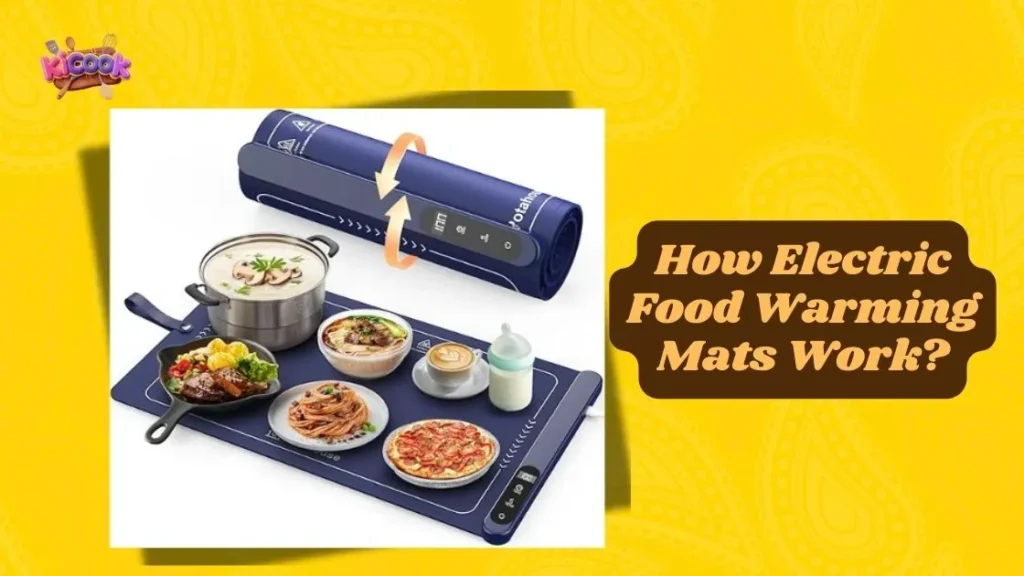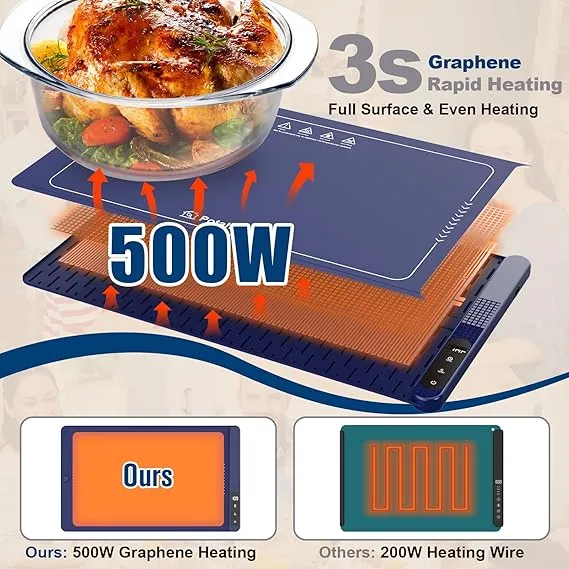Food warming mats are taking over social media, and you can grab a popular model on Amazon for just $45. These clever devices pack impressive features and heat up their spacious 15 by 23-inch surface from mild warmth all the way to near-boiling temperatures.
Electric warming trays and silicone heating mats show up everywhere from homes to restaurants because they nail temperature control within 1°C. The sort of thing I love about these mats is how they heat up in 5 seconds flat and let you pick from eight temperature settings between 104°F and 230°F. Let’s dive into the science that makes these heating solutions work so well and see how they keep temperatures steady while staying safe and efficient.
Resistive Heating Technology in Electric Warming Trays
Electric food warming mats work on a simple yet clever physics principle – resistive heating. These devices have heating elements inside silicone or similar materials that turn electrical energy into precise, controlled heat.
How Electrical Energy Converts to Heat
Electricity flowing through a conductor with resistance makes electrons bump into atoms in the material. This energy transfer shows up as heat. Scientists call this Joule heating, and it’s what makes all electric warming trays work. The math is straightforward: one amp flowing through one ohm of resistance generates exactly one watt of power. Food warming mats use special resistive elements that create predictable heat when electricity runs through them.
The makers put the heating element between two silicone layers. They arrange these elements in snake-like patterns that give even heat across the surface. This smart design stops hot spots from burning food or damaging the tray.
Nichrome Wire vs. Carbon Fiber Elements
Modern food heating mats mainly use two types of heating elements:
| Feature | Nichrome Wire | Carbon Fiber |
|---|---|---|
| Efficiency | Traditional standard | Reduces power consumption by 20-40% |
| Thermal Properties | Good conductivity | High far-infrared radiation (8-15μm) |
| Durability | Prone to breaking with repeated bending | Higher resistance to breakage |
| Weight | Heavier | By a lot lighter |
Nichrome wire has been around longer because it’s cheaper and has an electrical resistivity of 1.1-1.5 × 10⁻⁶ Ω·m. But carbon fiber elements are becoming more popular in premium food warming mats. Carbon fiber heats the whole surface evenly, unlike nichrome wire that needs extra layers to spread the heat.
Power Density and Heat Output Calculations
Power density measures how much power processes per unit area. This measurement in watts per square inch (W/in²) or watts per square meter (W/m²) determines how fast and evenly a food warming mat heats up.
Manufacturers adjust watt density in silicone heating mats based on their use. More watts mean more heat, while fewer watts give gentle warming. They use this formula:
Watt Density = Element Wattage / (3.14 × Element Diameter × Heated Length)
Quality electric food warming mats stay below 60 W/in² to stay safe and last longer. This careful setup lets them reach working temperatures quickly—sometimes in just 8-10 seconds—while staying durable and energy efficient.
Thermal Conductivity of Food Heating Mat Materials
The performance, efficiency, and safety of electric food warming mats depend on their materials. Heat moves through these mats based on thermal conductivity—knowing how to transfer heat is the foundation of their operation.
Silicone vs. Glass: Heat Transfer Properties
Silicone leads the food warming mat market because we found it transfers heat quickly across the mat surface. This material heats up fast and maintains consistent temperatures throughout. Silicone’s durability makes it perfect for this job, and it won’t stain or absorb oils.
Glass works differently—it actually blocks heat instead of conducting it. Glass surfaces alone create uneven temperatures that can vary by more than 30°C. Tests reveal temperature drops of 5°C at 65°C settings and about 10°C at 110°C settings. Food placed on different spots would heat unevenly because of this issue.
Aluminum Heat Spreading Layers
Modern food warming mats rely heavily on aluminum. Its thermal conductivity of 237 W/m•K is a vital part of their design. Aluminum sits between the heating element and surface material and acts like a thermal highway that spreads heat evenly.
Adding aluminum makes a big difference in temperature uniformity. Thermal imaging shows that surfaces with aluminum heat spreaders perform ten times better at distributing temperature than those without. This explains why quality food warming mats have aluminum layers under their silicone surfaces.
Temperature Gradient Across Mat Surfaces
Temperature differences naturally develop across heating mat surfaces, even with the best materials. Smart designs use honeycomb heating patterns and large-area heating wires to keep these variations small. The microarc heating technology creates 3D warming effects that help maintain even heat distribution.
Food warming mats work best with surface temperatures between 60°C and 100°C (140°F-212°F). These temperatures create uniform heating zones safely without any dangerous hot spots that could burn food or cause safety issues.

Temperature Control Systems in Silicone Heating Mats
Temperature management lies at the core of food warming mats. Smart systems keep your dishes at perfect serving temperatures without overcooking or letting them get cold.
Thermistor-Based Temperature Sensing
Premium silicone heating mats use negative temperature coefficient (NTC) thermistors to detect temperature. These specialized resistors reduce their resistance when temperature rises, which gives quick feedback to the control system. Quality food warming mats reach impressive accuracy within +/- 1°C through these sensors.
Thermistors show non-linear resistance against temperature changes, which needs advanced signal conditioning. Manufacturers place these sensors carefully under the silicone surface where they detect actual temperature without food interference.
PID Controllers for Precise Heat Regulation
PID (Proportional-Integral-Derivative) controllers lead the way in temperature regulation for electric warming trays. These controllers work better than simple on/off systems because they:
- Analyze current temperature variance (Proportional)
- Account for previous temperature history (Integral)
- Predict future temperature changes (Derivative)
This three-term algorithm helps food warming mats keep temperatures within 1°F of the target setting. Many high-end models also include “Autotune” features that let the controller “learn” your mat’s specific heating patterns.
Digital vs. Analog Temperature Control
The difference between digital and analog control systems affects warming mat performance substantially:
| Feature | Digital Control | Analog Control |
|---|---|---|
| Accuracy | Within 0.1% for temperature | Typically varies by several degrees |
| Display | Exact temperature readout | Often unmarked dials |
| Settings | Precise temperature levels (140°F, 176°F, 212°F) | Approximate temperature ranges |
| Programming | Adjustable timers with auto shut-off | Minimal programming capability |
Modern electric food warming mats mostly use digital controls with preset temperature levels. These systems distribute power through solid-state relays or silicon-controlled rectifiers that respond to temperature changes within milliseconds. Your food stays at consistent warming temperatures for hours of service.

Energy Efficiency and Safety Features
Safety is a top priority in food warming mat design. Manufacturers build various features that balance quick operation with user protection.

Power Consumption Metrics (Watts per Square Inch)
Food warming mats use between 50 to 200 watts of power. Most operate at the lower end during regular use. A medium-sized electric food warming tray uses about 80 watt-hours when used for two hours daily. This adds up to 2.4 kWh monthly and 29.2 kWh annually. The cost comes to roughly $0.64 per month or $7.68 per year based on average electricity rates.
Better quality silicone heating mats come with smart temperature control systems. These systems adjust heating power based on what you need, which saves energy. The mats keep exact temperatures without drawing maximum power constantly.
Automatic Shutoff Mechanisms
Today’s electric food warming mats come with timed automatic shutoff features as a standard safety measure. Timer options vary by model:
- 1-hour shutoff for residential use models
- 3-hour shutoff for entertaining and party-focused units
- 12-hour shutoff for commercial applications
This feature stops potential hazards from unattended operation and saves energy by preventing unnecessary heating.
Overheat Protection Circuits
Advanced food heating mats use multiple protection layers against thermal runaway:
Positive Thermal Coefficient (PTC) technology stops overheating. It uses materials that naturally increase resistance as temperature rises. The integrated temperature limiters kick in at 107.6°F (42°C). This creates a mechanical safeguard that works independently from electronic controls.
Premium models also feature sealed heating elements to protect against liquids, which helps handle kitchen moisture risks.
UL and ETL Safety Certifications
UL (Underwriters Laboratories) and ETL (Electrical Testing Laboratories) certifications prove critical safety standards. These organizations verify safety differently:
UL creates its own strict safety standards and tests products. ETL certifies products using existing standards, including those from UL. Both organizations look at electrical safety, fire resistance, moisture protection, and mechanical durability thoroughly.
Products with either certification get yearly inspections. This ensures they keep meeting critical safety requirements throughout production.

Conclusion
Electric food warming mats showcase an impressive combination of simple physics principles and advanced temperature control technology. These devices deliver precise, uniform heating through careful material selection and engineering while maintaining safety and efficiency.
The thoughtful design choices make modern warming mats stand out. Carbon fiber elements distribute heat better than traditional nichrome wire. The aluminum layers strategically placed ensure even temperature distribution across silicone surfaces. These mats use advanced PID controllers with thermistor sensors to maintain temperatures within 1°C accuracy. This precision makes them reliable for homes and commercial kitchens.
Safety remains the life-blood of warming mat design. Users can operate these devices without worry thanks to automatic shutoff mechanisms, overheat protection circuits, and strict UL/ETL certifications. On top of that, smart power management keeps energy consumption modest – usually between 50 to 200 watts. This efficiency makes them practical for everyday use.
These heating solutions show how simple resistive heating principles work alongside careful material choices and sophisticated control systems. The result is a practical tool that keeps food at perfect serving temperatures. This effective combination of simplicity, safety, and precise temperature control explains their growing popularity.
Frequently Asked Questions For Electric Food Warming Mats
How do electric food warming mats maintain consistent temperatures?
Electric food warming mats use resistive heating technology and PID controllers to maintain precise temperatures. The PID controllers analyze current temperature, account for past temperature history, and predict future changes, allowing the mat to maintain temperatures within 1°F of the target setting.
What materials are commonly used in food warming mats?
Food warming mats typically use silicone as the primary material due to its high thermal conductivity. Many also incorporate aluminum layers for even heat distribution. Some premium models use carbon fiber heating elements, which are more efficient and provide uniform surface heating compared to traditional nichrome wire.
Are electric food warming mats energy-efficient?
Yes, most electric food warming mats are designed to be energy-efficient. They typically consume between 50 to 200 watts of power, with many operating at the lower end of this spectrum during regular use. High-quality mats feature intelligent temperature control systems that adjust heating power according to actual demand, reducing unnecessary energy consumption.
What safety features do electric food warming mats have?
Electric food warming mats come with several safety features, including automatic shutoff mechanisms, overheat protection circuits, and sealed heating elements for liquid protection. Many also have PTC technology that naturally increases resistance as temperature rises to prevent overheating. Additionally, these mats often carry UL or ETL safety certifications.
What temperature range can electric food warming mats achieve?
Most electric food warming mats can maintain surface temperatures between 60°C and 100°C (140°F-212°F). Many models offer adjustable temperature settings, with some providing a range from 104°F to 230°F across multiple levels. This allows for versatile use in keeping various types of food at optimal serving temperatures.



